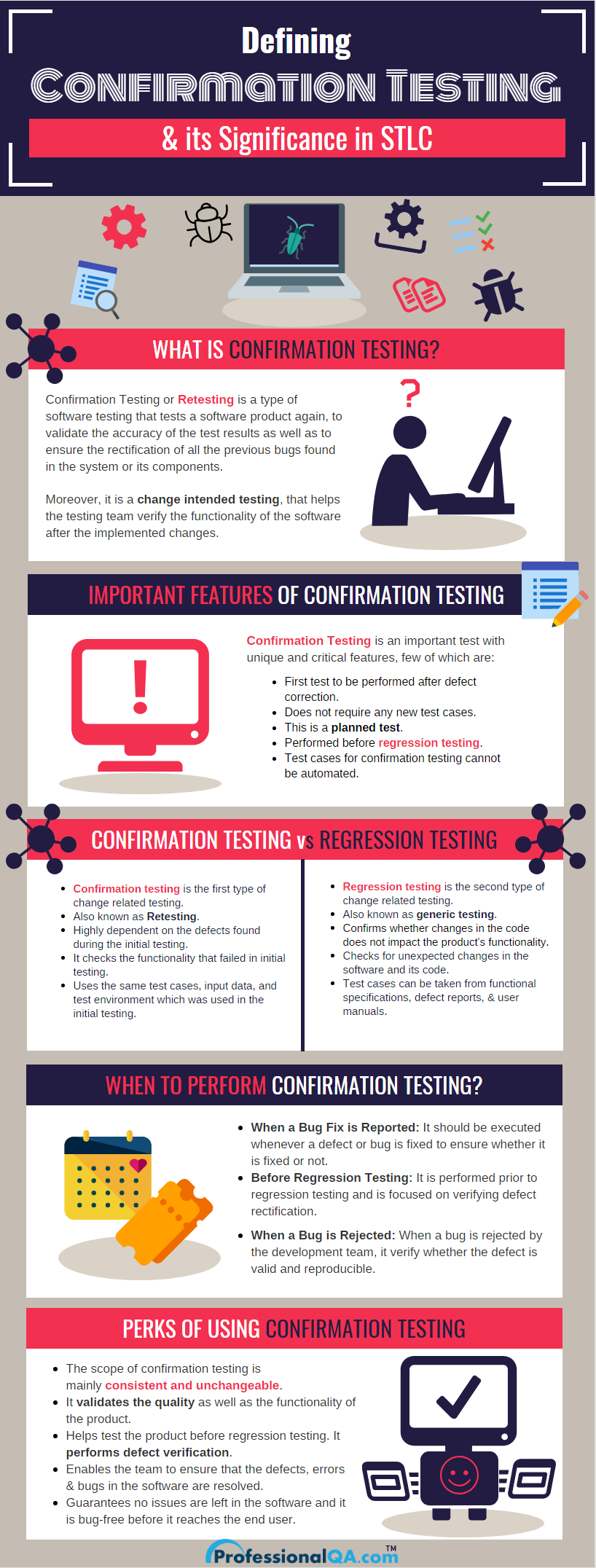

A software product is examined through various testing techniques to ensure that it successfully performs its intended functions, without any deviances or issue. Used by the Quality Assurance team to get accurate results, confirmation testing is amongst the most important types of testing that validates the quality of a product as well as its components. With the intent to explain to you the significance of this type of testing, provided here is a comprehensible discussion on confirmation testing.
A type of software testing technique, Confirmation Testing or Retesting, tests a software product again, to validate the accuracy of its test results and to ensure the rectification of all the previous bugs found in the system or its components.
In this type of testing, test cases that were earlier effective in detecting the defects in the software product, are again executed after the bugs in the product are fixed. This is done to ensure that the software product which was not able to pass the test cases, is now able to pass these test cases after applying corrections in the software product in order to remove bugs.
Example:After the development of a software product, it is When a software product is developed by the development team, it goes through testing activities that validate its quality. However, after the execution of the tests, some defects were found in the software that needs to be fixed or resolved before it is termed ready for release.
It is after all these defects, issues, and bugs are rectified that the need for confirmation testing arises, as it tests whether or not After applying corrections to the software product, it is required to check whether the defects that were explored, got fixed or not. This situation, then calls for the confirmation testing.

A type of change intended testing, confirmation testing, is performed by the testing team to verify the functionality of the software after the implemented changes. Since the importance of this type of testing is immense in the software testing life cycle (STLC), it is important for us to understand its various features, such as:
Though both confirmation testing and regression testing are types of change related tests performed during the Software Development Life Cycle (SDLC), they are vastly different from one another.
Regression testing ensures that the modifications introduced in the software product, to remove the bugs, do not impact its existing functionality. Whereas, the focus of confirmation testing is on retesting the software, to check that the bugs or defects,found during the previously performed testing have been removed or not.
To further help you to understand the differences between confirmation testing and regression testing, performed here is a detailed comparison between the two.
| Confirmation Testing | Regression Testing |
| 1. Confirmation testing is the first type of change related testing. | 1. Regression testing is the second type of change related testing. |
| 2. It is also known as Retesting. | 2. It is also known as generic testing. |
| 3. It is highly dependent on the defects found during the initial testing. | 3. It is carried out to confirm whether a recent change in the software code has not affected the product’s functionality. |
| 4. Confirmation testing cannot be automated. | 4. Regression testing is mostly automated. |
| 5. It checks the functionality that failed in initial testing. | 5. It checks for the unexpected changes in the software and its code. |
| 6. It uses the same test cases, input data, and test environment which was used in the initial testing. | 6. Here, test cases can be taken from functional specifications, defect reports, and user manuals. |
To know more about the differences between these two types of testing, check out our next article on regression vs retesting.
A commonly asked question regarding confirmation testing is when to perform it during the software testing life cycle. To simplify this confusion, listed below are the instances when there is a requirement of confirmation testing.
From verifying defect detection to ensuring their rectification, there are numerous advantages of performing confirmation testing, such as:
From the above discussion we can conclude that the importance of confirmation testing is immense in software development life cycle and with its assistance the testing team can ensure the functionality of the software as well as its quality, while validating whether the various defects found during initial testing are fixed or not.
Advertisement: